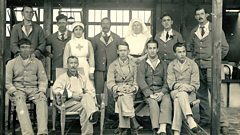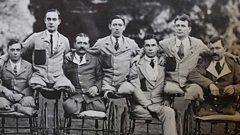
Royal Victoria Hospital
Shocking stories of the World War One Hampshire hospital doctors who faked footage on cures for shell shock. Author Philip Hoare examines the evidence and reveals some other real life human tragedies at the Royal Victoria Hospital in Netley.
Clip
-
![]()
Inside the Royal Victoria Hospital
Duration: 01:39
Royal Victoria Hospital

Netley on the south coast of Hampshire was the location for the largest military hospital ever built.
More than 100,000 soldiers were treated at the hospital during both the First and Second World Wars.
Florence Nightingale, the founder of modern nursing, was said to have hated the building's design.��She thought the design was "old fashioned" and thought the long corridors could lead to the spread of disease.
��
The military hospital was a quarter of a mile long, the largest brick building of its age with over a thousand beds.
It was originally founded in 1856 after Queen Victoria decreed that a new hospital should be built to cater for soldiers in better conditions.
Behind the hospital a Red Cross extension building housed a further 2,500 beds. Many of the soldiers cared for in the Red Cross hospital were cared for by volunteers known as Voluntary Aid Detachments (VADs).��
Tucked away out of sight was D-Block, the first purpose-built military asylum. It was here that the fate of soldiers would be decided between going home, being sent to a lunatic asylum or being sent back to the front.
The hospital complex included officers’ quarters, a railway station, stables and gasworks. It also had its own dedicated pier.
The war poet Wilfred Owen was a patient at Netley in 1917 after being injured in action. He had been hit by a shell when serving on the front line. During his brief stay at Netley he was assessed for shell shock.
The hospital was demolished in 1966 after falling into disrepair and being partially destroyed by a fire. Most of its medical records were destroyed.
The site of the hospital is now a country park. Some small parts of the original hospital remain including the officers' mess (now private flats), the tower and a few asylum buildings.
��
How did WW1 change your world?
Discover how war changed the people & places of the UK: stories, clips, galleries, search


